Mediante esta publicación se discutirán algunos aspectos generales sobre una de las familias de lepidópteros más comunes que existe, caracterizados por tener ejemplares de muy pequeño tamaño, siendo por este motivo ignorados por una gran parte de las personas; sin embargo, en este artículo se darán a conocer parte de sus principales fortalezas y se destacará su importancia ecológica.
This publication will discuss some general aspects of one of the most common families of Lepidoptera, characterized by very small specimens, being for this reason ignored by a large part of the people; however, in this article some of its main strengths will be presented and its ecological importance will be highlighted.
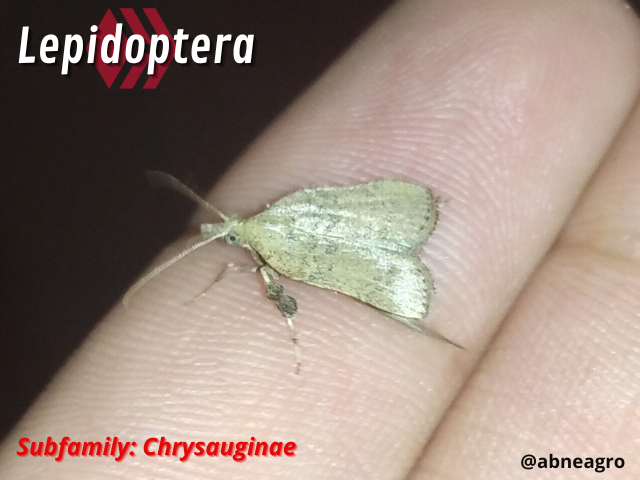.png)
Generalmente, las personas están ampliamente familiarizadas con las mariposas diurnas, estos son de los insectos que con mayor frecuencia podemos observar en aquellas zonas en donde hay presencia de organismos vegetales en su etapa de floración, ya que estos lepidópteros son atraídos por las flores de las cuales obtienen el néctar que necesitan para su alimentación, también pueden llegar a colocar sus huevos en aquellas plantas que le sirvan como fuente de nutrición a sus estadios juveniles (orugas), siendo muchos de estos lepidópteros plagas muy recurrentes dentro de los agroecosistemas. Aun así, no todo lo que involucre a mariposas o polillas es negativo, ya que estos hexápodos contribuyen en las labores de polinización, son el alimento de otros miembros del reino animal y son excelentes indicadores ambientales, es decir, que una alta presencia de lepidópteros en un determinado lugar es un buen indicativo de poca contaminación.
Ahora bien, lo que muchos no saben es que en la noche es cuando hay más mariposas o polillas revoloteando en los espacios urbanos y naturales, y es que, la mayoría de lepidópteros son de hábitos nocturnos y una minoría son diurnas; sin embargo, nuestra limitada capacidad para ver en la oscuridad es lo que nos limita a no poder percibir a este tipo de insectos, exceptuando aquellas situaciones en la que estos invertebrados ingresan a nuestros hogares atraídos por los focos de luz que usamos para iluminar.
Generally, people are widely familiar with diurnal butterflies, these are the insects that we can observe most frequently in those areas where there is presence of plant organisms in their flowering stage, since these lepidoptera are attracted by the flowers from which they obtain nectar, they can also lay their eggs in those plants that serve as a source of nutrition to their juvenile stages (caterpillars), being many of these lepidoptera very recurrent pests within agroecosystems. Even so, not everything involving butterflies or moths is negative, since these hexapods contribute to pollination, are food for other members of the animal kingdom and are excellent environmental indicators, so a high presence of lepidoptera in a given place is a good indication of low contamination.
Now, what many do not know is that at night is when there are more butterflies or moths fluttering in urban and natural spaces, and is that, most lepidoptera are nocturnal habits and a minority are diurnal; however, our limited ability to see in the dark is what limits us to not being able to perceive this type of insects, except in those situations in which these invertebrates enter our homes attracted by the bulbs we use to illuminate.
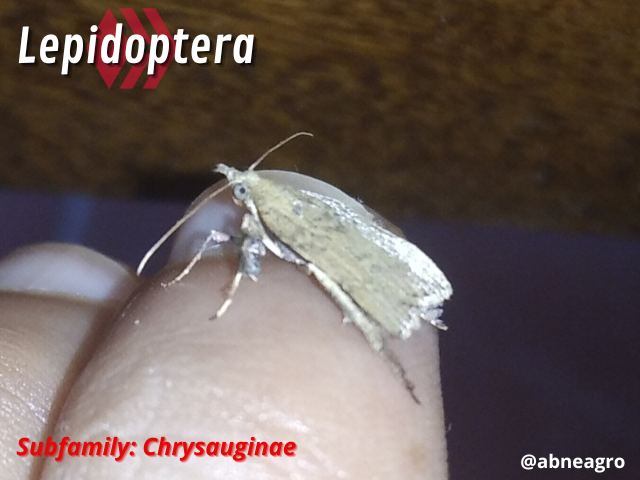.png)
Es algo completamente normal encontrar a estos insectos en la cercanía de nuestras lámparas u otro foco de iluminación artificial, no es un símbolo de mal presagio como muchas personas piensan, sino que es debido a que la polilla se confunde por la iluminación y pierde su camino; es importante acotar que las mariposas diurnas emplean al sol como referencia para guiarse durante sus vuelos, mientras que las polillas están adaptadas de otra manera y en lugar del sol emplean la luna (son nocturnas), por este motivo la luz de nuestros hogares las desorientan al percibir "varias lunas" en sus alrededores.
Por otro lado, algunos de estos insectos destacan principalmente por los colores que hay en sus cuerpos, pero no todos son tan llamativos, siendo las especies nocturnas las que tienden a tener menos colores, claramente se debe a que dichas tonalidades muy marcadas son menos efectivas en la oscuridad de la noche, por ello sus cuerpos tienen colores más opacos como predominantes. De igual manera, así como hay muchas mariposas de gran tamaño, otras son extremadamente minúsculas, siendo conocidas comúnmente como microlepidópteros.
It is completely normal to find these insects in the vicinity of our lamps or other artificial lighting, it is not a symbol of bad omen as many people think, but it is because the moth gets confused with the lighting and gets lost; It is important to note that diurnal butterflies use the sun as a reference to guide them during their flights, while moths are adapted differently and instead of the sun they use the moon (they are nocturnal), for this reason the light of our homes disorients them by perceiving "several moons" in their environment.
On the other hand, some of these insects stand out mainly because of their body colors, but not all are so striking, being the nocturnal species those that usually have less colors, clearly it is because such marked tones are less effective in the darkness of the night, so their bodies have more opaque colors as predominant. Similarly, just as there are many large butterflies, others are extremely tiny, being commonly known as microlepidoptera.
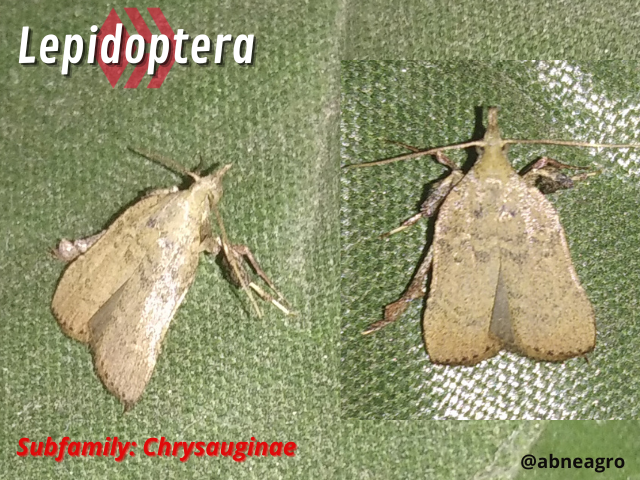.png)
Aquellas mariposas o polillas que tienen un tamaño inferior a los 10 milímetros son las que generalmente entran en el rango de los llamados microlepidópteros, este tipo de polillas llegan a resultar menos atractivos para las personas, incluso pueden ser confundidos con otros pequeños insectos. A su vez, estas diminutas polillas son las que más podemos encontrar en nuestros alterados espacios, siendo consideradas muchas como plagas por el hecho de que pueden dañar nuestras prendas de vestir o cuando sus poblaciones son elevadas, sus orugas dejan los pequeños estuches que la resguardaban en gran cantidad por diferentes áreas de las viviendas humanas, esto ocurre con algunas especies de la familia Tineidae.
De igual manera, también existen otras familias de pequeños lepidópteros que pueden ser plagas de mucha importancia dentro de la agricultura, el daño que generan las orugas llega a ser muy pronunciado cuando hay un crecimiento exponencial de poblaciones, momento en el que superan el umbral de daño y pasan a ser denominadas "plagas" y se requiere de un manejo adecuado para reducir las posibles pérdidas o para evitar que haya una gran bajada en el rendimiento del cultivo. El problema está en que al ser muy pequeño el adulto, entonces la oruga tiende a ser aun más pequeña en las primeras fases, lo que puede dificultar el encontrarlas en un inicio, por ende, el monitoreo de los cultivos debe ser lo más exhaustivo que se pueda, siendo el uso de trampas cromotrópicas una alternativa inicial para capturar ejemplares adultos y así tener una idea de los tipos de insectos que pueden resultar problemáticos a corto o largo plazo.
Those butterflies or moths that have a size of less than 10 millimeters are those that generally fall into the range of the so-called microlepidoptera, this type of moths become less attractive to people, they can even be confused with other small insects. In turn, these tiny moths are the ones that we can find more in our altered spaces, being considered many as pests by the fact that they can damage our clothing or when their populations are high, their caterpillars leave the small cases that sheltered them in large numbers in different areas of human dwellings, this happens with some species of the family Tineidae.
Similarly, there are also other families of small lepidoptera that can be very important pests in agriculture, the damage generated by caterpillars becomes very pronounced when there is an exponential growth of populations, at which time they exceed the threshold of damage and become known as "pests" and requires proper management to reduce potential losses or to prevent a large drop in crop yield. The problem is that since the adult is very small, then the caterpillar tends to be even smaller in the early stages, which can make it difficult to find them at the beginning, therefore, crop monitoring should be as exhaustive as possible, being the use of chromotropic traps an initial alternative to capture adult specimens and thus have an idea of the types of insects that may be problematic in the short or long term.
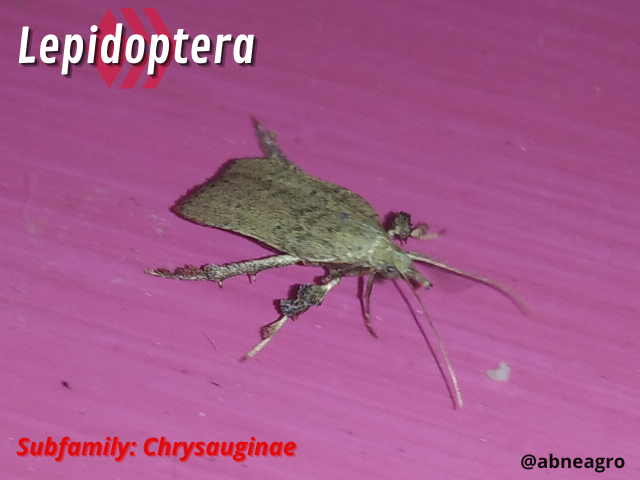.png)
Algunas de las familias de lepidópteros de poco tamaño que pueden tener importancia a nivel agrícola podrían ser la Gelechiidae, Cosmopterigidae o la Pterophoridae, pero también se incluyen la Pyralidae y la Crambidae por mencionar algunos ejemplos. Las dos últimas familias mencionadas son de las más conocidas y también están estrechamente ligadas, ya que sus ejemplares comparten muchos aspectos en común, por este motivo a lo largo de la historia ciertas especies que estaban ancladas a una de estas familias eran transferidas a la otra cuando se realizaban nuevos descubrimientos que alejaban a dicha especie de la familia a la que perteneció por cierto tiempo; la diferencia entre los ejemplares de estas familias radica más que todo en que los de Crambidae tienen una estructura auditiva con una conformación única que no esta presente en los miembros de Pyralidae, esta solo puede ser vista con microscopio, motivo por el que la confusión a simple vista entre determinados ejemplares de estas dos familias es algo frecuente.
Some of the small lepidopteran families that may have importance at the agricultural level could be the Gelechiidae, Cosmopterigidae or the Pterophoridae, but also include the Pyralidae and Crambidae to mention some examples. The last two families mentioned are among the best known and are also closely linked, since their specimens share many aspects in common, for this reason throughout history certain species that were anchored to one of these families were transferred to the other when new discoveries were made that moved that species away from the family to which it belonged for a certain time; the difference between the specimens of these families lies mainly in the fact that those of Crambidae have an auditory structure with a unique conformation that is not present in the members of Pyralidae, this can only be seen with a microscope, which is why confusion at first sight between certain specimens of these two families is frequent.
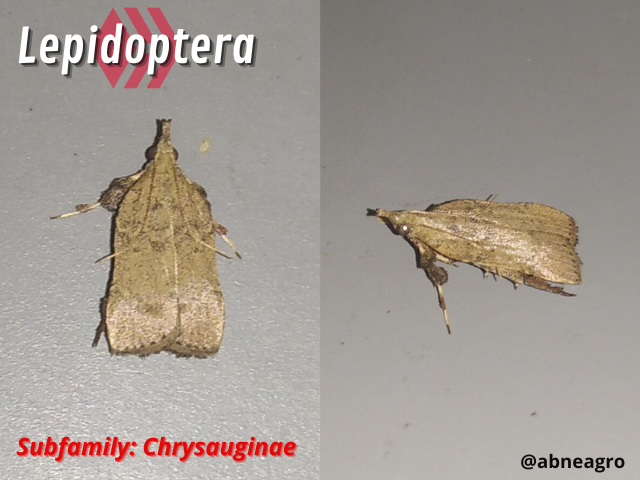.png)
Tanto Pyralidae como Crambidae en su conjunto, forman parte activa de la superfamilia Pyraloidea, es un taxón que alberga a miles de especies con amplia distribución en nuestro planeta. Tan solo en Pyralidae hay un estimado de más de 5.000 especies, mismas que se distribuyen en 5 subfamilias, siendo estas la: Pyralinae, Galleriinae, Phycitinae, Epipaschiinae y la Chrysauginae; de estas, Phycitinae es la que más ejemplares descritos tiene con un estimado de 4.000 aproximadamente. De igual manera, la subfamilia Chrysauginae es de las que personalmente considero de las más difíciles de identificar, pues, algunas de sus especies son muy semejantes entre si, además hay muy pocas claves taxonómicas de fácil acceso sobre esta subfamilia que faciliten esta labor.
Both Pyralidae and Crambidae as a whole, are an active part of the superfamily Pyraloidea, a taxon that harbors thousands of species with a wide distribution in our planet. Only in Pyralidae there are an estimated of more than 5,000 species, distributed in 5 subfamilies, being these the: Pyralinae, Galleriinae, Phycitinae, Epipaschiinae and the Chrysauginae; of these, Phycitinae has the most described specimens with an estimated 4,000 approximately. Similarly, the subfamily Chrysauginae is one of those that I personally consider the most difficult to identify, because some of its species are very similar to each other, and there are very few taxonomic keys easily accessible on this subfamily to facilitate this work.
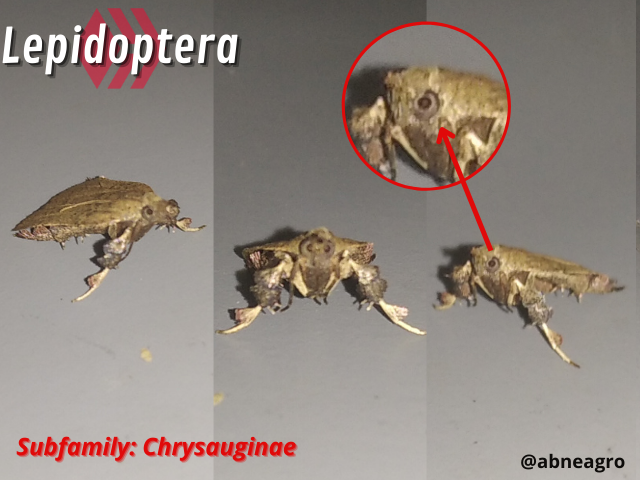.png)
Esta subfamilia se caracteriza por poseer ejemplares con tamaño que se sitúan entre los 10 milímetros de longitud, sus cuerpos poseen pocas tonalidades llamativas y la predominancia de colores como el negro, gris o el marrón son los más habituales; sin embargo, el aspecto que más llama la atención de toda su morfología resultan ser sus patas, estas unidades de locomoción están muy cubiertas por pubescencia que resultan ser las escamas que tienen los lepidópteros por todo sus cuerpos, estas pequeñas estructuras tienen diversas formas y tamaños, las de sus alas suelen ser aplanadas y en su conjunto son las encargadas de darle la coloración al cuerpo, además de tener otras funciones como la de preservar la temperatura o la de dar protección. Las escamas que tienen en sus patas son alargadas y se asemejan a pelos, estas no están repartidas en su totalidad por dichas extremidades, sino que se acumulan y forman una especie de cepillo que hace que las patas se vean gruesas en ciertas zonas, esto en el caso de la mayoría de miembros de esta subfamilia conocida como Chrysauginae, ya que en otras polillas la distribución de dicha pubescencia es más uniforme.
This subfamily is characterized by specimens with sizes between 10 millimeters in length, their bodies have few striking shades and the predominance of colors such as black, gray or brown are the most common; However, the most striking aspect of all their morphology are their legs, these locomotion units are heavily covered by pubescence which are the scales that Lepidoptera have all over their bodies, these small structures have different shapes and sizes, those of their wings are usually flattened and as a whole are responsible for giving coloration to the body, besides having other functions such as preserving the temperature or providing protection. The scales they have on their legs are elongated and resemble hairs, these are not distributed in its entirety by these extremities, but accumulate and form a kind of brush that makes the legs look thick in certain areas, this in the case of most members of this subfamily known as Chrysauginae, since in other moths the distribution of such pubescence is more uniform.
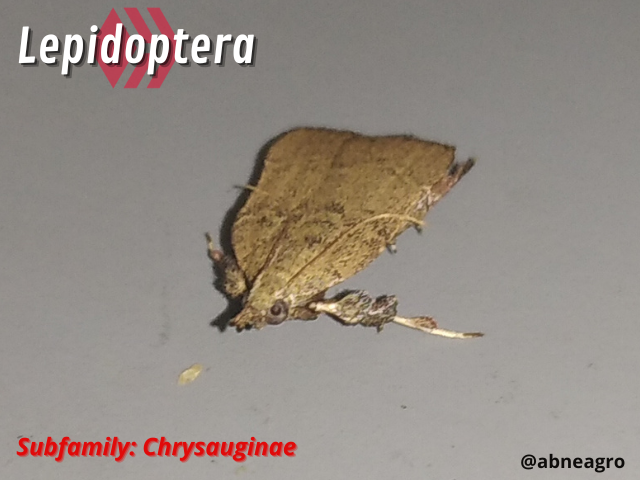.png)
Por otro lado, al ver sus ojos compuestos puede dar la sensación de que nos observa fijamente, hago mención de dicho aspecto porque se aprecia algo muy similar a una pupila y es un punto que causa curiosidad en las personas; no obstante, esto no es algo que pertenezca al ojo de esta polilla, se debe a un efecto óptico que se genera por la acción de la luz cuando impacta sobre la superficie de dicha estructura, por ende, esto produce un punto oscuro que se asemeja a una pupila, este fenómeno se denomina pseudopupila y puede estar presente en otros insectos, siendo el más famoso el caso de las llamadas mantis religiosas.
Otro factor asociado a su conducta y morfología es la postura que toman al posarse sobre alguna superficie, en las imágenes mostradas hasta el momento se aprecia como esta polilla mantiene erguida la parte anterior de su cuerpo empleando para ello el primer par de patas, esta postura es realmente llamativa ya que difiere con lo que muestran la mayoría de lepidópteros, aun así, es algo que poseen algunos miembros de ciertas subfamilias como la Chrysauginae.
On the other hand, seeing its compound eyes can give the sensation that it is staring at us, I mention this aspect because something very similar to a pupil can be seen and it is a point that causes curiosity in people; however, this is not something that belongs to the eye of this moth, it is due to an optical effect that is generated by the action of light when it hits the surface of the structure, therefore, this produces a dark spot that resembles a pupil, this phenomenon is called pseudopupil and may be present in other insects, the most famous being the case of the so-called praying mantis.
Another factor associated with their behavior and morphology is the posture they take when perching on a surface, in the images shown so far we can see how this moth keeps upright the anterior part of its body using the first pair of legs, this posture is really striking as it differs from what most lepidoptera show, even so, it is something that some members of certain subfamilies such as Chrysauginae possess.
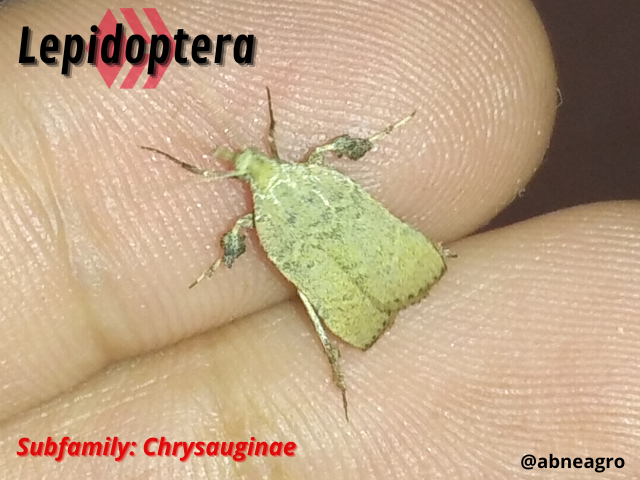
Esta subfamilia no es muy numerosa, ya que está integrada hasta el momento tan solo por unos 400 ejemplares, por este motivo tienden a ser muy poco conocidas. Asimismo, son de hábitos nocturnos y pueden llegar a terminar dentro de nuestros hogares cuando hace mal tiempo o por la atracción que genera la luz artificial; a su vez, como suele ocurrir con otros lepidópteros, estas pueden ser plagas de algunos organismos vegetales durante sus estadios juveniles, en donde pueden tener preferencia por diferentes partes de las plantas como frutos, hojas o semillas, pero se consideran plagas menores por el hecho de que sus poblaciones muy rara vez superan el umbral de daño, pero nunca deben subestimarse y se deben mantener observadas o controladas sobre aquellas plantas que sean de importancia productiva. De igual manera, algunos miembros de esta subfamilia pueden llegar a coexistir en el pelaje de ciertos mamíferos, además también se han encontrado estadios juveniles de estas polillas entre himenópteros y otros insectos, pero la relación o la razón de este comportamiento sigue siendo desconocida.
Personalmente, considero que este acercamiento de estas polillas a otros organismos es más que todo como medio de protección y, sobre todo, para el transporte de sus orugas, siendo esto lo que se conoce como foresis.
This subfamily is not very numerous, since it is so far composed of only about 400 specimens, which is why they tend to be little known. Also, they are nocturnal and can end up inside our homes when the weather is bad or because of the attraction generated by artificial light; in turn, as it usually happens with other Lepidoptera, these can be pests of some plant organisms during their juvenile stages, where they may have preference for different parts of plants such as fruits, leaves or seeds, but are considered minor pests because their populations very rarely exceed the threshold of damage, but should never be underestimated and should be kept observed or controlled on those plants that are of productive importance. Similarly, some members of this subfamily may even coexist on the fur of certain mammals, and juvenile stages of these moths have also been found among hymenopterans and other insects, but the relationship or reason for this behavior remains unknown.
Personally, I consider that this approach of these moths to other organisms is mostly as a means of protection and, above all, for the transport of their caterpillars, this being what is known as phoresis.
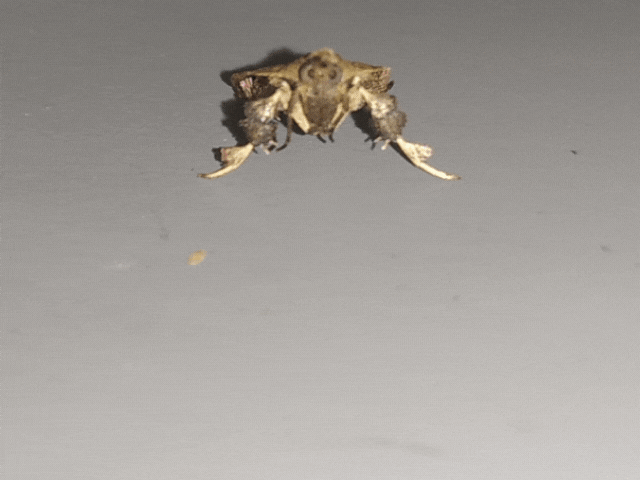
A lo largo de mi aventura por Hive he realizado varias publicaciones referentes a lepidópteros, todo con el propósito de mostrar lo interesante e importantes que llegan a ser estos artrópodos que en ocasiones son menospreciados por las personas, el valor que tienen estos insectos en los ecosistemas es incalculable e irreemplazable, por este motivo la protección de los mismo es vital para mantener un sano funcionamiento de los espacios naturales. En este sentido, en la actualidad han sido muchos los profesionales que han luchado activamente para mantener las poblaciones de diversos artrópodos, siendo uno de los casos más llamativos el que fomentó el ingeniero agrónomo Mexicano Homero Gómez, quien fue uno de los defensores activos de una de las especies de mariposas más hermosas que existe, la mariposa monarca Danaus plexippus, misma que se encuentra en peligro de extinción. Este gran profesional se opuso a la reducción de la capa vegetal que generaba la tala de arboles indiscriminada que afectaba a estas mariposas y fue asesinado por esta razón; sin embargo, su trabajo en vida rindió frutos y las poblaciones de estos insectos aumentaron. Por mi parte, como profesional siempre recomiendo el control de todos los artrópodos cuando sus poblaciones se desequilibren y nunca el exterminio de los mismos, cada ser vivo merece su espacio y el respeto de nuestra parte. ¡Gracias por leer!
Throughout my adventure for Hive I have made several publications about lepidoptera, all with the purpose of showing how interesting and important these arthropods become, which are sometimes underestimated by people, the value of these insects in ecosystems is incalculable and irreplaceable, for this reason their protection is vital to maintain a healthy functioning of natural spaces. In this sense, there have been many professionals who have actively fought to maintain the populations of various arthropods, being one of the most striking cases the one promoted by the Mexican agronomist Homero Gomez, who was one of the active defenders of one of the most beautiful butterfly species that exists, the monarch butterfly Danaus plexippus, which is in danger of extinction. This great professional was opposed to the reduction of the vegetation cover generated by the indiscriminate felling of trees that affected these butterflies and was murdered for this reason; however, his life's work paid off and the populations of these insects increased. For my part, as a professional I always recommend the control of all arthropods when their populations are unbalanced and never the extermination of them, every living being deserves its space and respect from our part. Thanks for reading!

Todas las fotografías presentadas en este post pertenecen al autor @abneagro. Las fotos fueron realizadas por un dispositivo móvil y se editaron con la aplicación Canva. Traducción realizada por medio de DeepL.
All photos presented in this post belong to the author @abneagro. The photos were taken by a mobile device and edited with the Canva application. Translation made through DeepL.

Some references:
Homero Gómez el guardian de la Monarca

.png)
Buenas tardes. Excelente información, sobre todo la referida al criterio para consider a un especimen como microlepidópteros.
Es muy lamentable que los ambientalista, a quienes deberíamos agradecer su gestión, terminen maltrechos por criminales que no les importa el ambiente.
Rescato esta idea : "Como profesional recomiendo el control de todos los artrópodos cuando sus poblaciones se desequilibren y nunca el exterminio de los mismos, cada ser vivo merece su espacio y el respeto de nuestra parte". Ese es el norte a seguir. Saludos.
aliriera
Así es amigo @aliriera, las grandes corporaciones van destruyendo todo a su paso movidos por el dinero, lamentablemente cuando alguien interfiere con pruebas a la mano sobre el impacto negativo que dichas empresas están haciendo sobre los ecosistemas, entonces ya se tiene un enemigo más que asegurado. Sin embargo, si no se corre el riesgo, entonces no les quedará nada a las generaciones futuras. Muchas gracias por su valoración, sé que usted como biólogo tiene un alta estima por la naturaleza y todo lo que la conforma, esto queda reflejado en sus excelentes y educativos aportes que regala a la comunidad, saludos!
Interesante información de estas pequeñas mariposas, la verdad siempre es sorprendente los detalles de estas amiguitas.
Saludos con cariño para ti. De regalo un 🌵
Siii, creo que mientras más pequeñas sean, entonces te darán menos miedo jajaja. Recibo ese cactus con un café y con mucho cariño, no importa si me pincho jajaja.
No me gustas mucho la mayoria de las brujas! Principal las brujas plagas! Buen texto
!1Up
Si, las más grandes son las que suelen dar sustos a las personas cuando ingresan a sus casas, pero estas son inofensivas para nosotros.
si claro! T. bisselliella mostly yo no me gustas jejejeje
Su post ha sido valorado por @ramonycajal
Muchas gracias por el apoyo amigos de @cervantes, un abrazo!
@tipu curate 2
Upvoted 👌 (Mana: 35/55) Liquid rewards.
Muchas gracias por la valoración de la publicación catire, un abrazo amigo!
Thanks for your contribution to the STEMsocial community. Feel free to join us on discord to get to know the rest of us!
Please consider delegating to the @stemsocial account (85% of the curation rewards are returned).
You may also include @stemsocial as a beneficiary of the rewards of this post to get a stronger support.
Thanks for the support!